1994 PONTIAC GRAND-AM tire type
[x] Cancel search: tire typePage 129 of 274
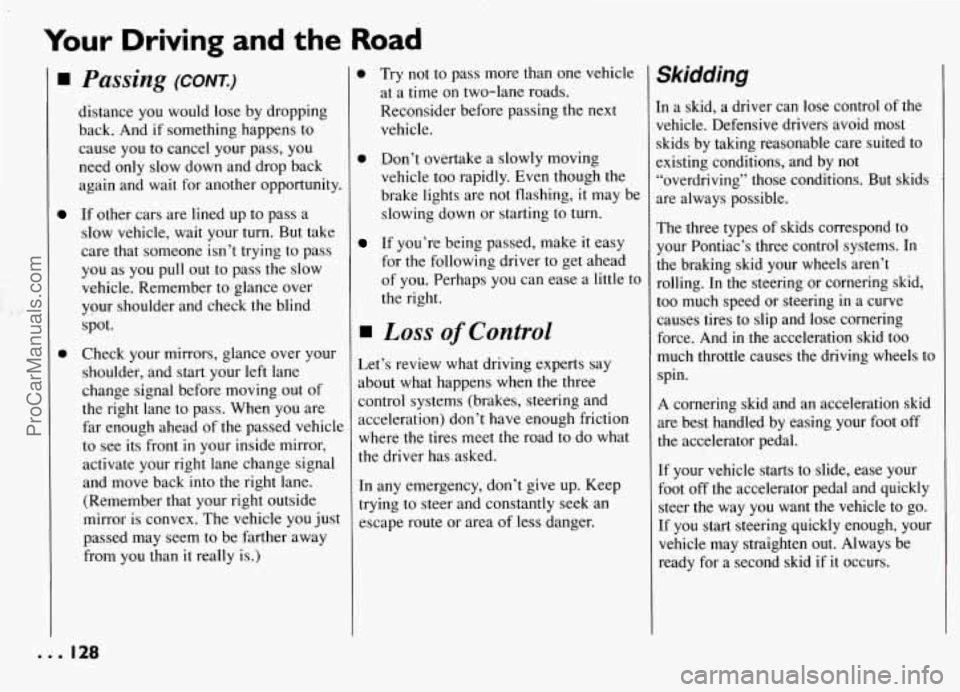
Your Driving and the Road
I
0
Passing (CONT.)
distance you would lose by dropping
back. And if something happens to
cause you to cancel your pass, you
need only slow down and drop back
again and wait for another opportunity.
If other cars are lined up to pass a
slow vehicle, wait your turn. But take
care that someone isn’t trying to pass
you as you pull out to pass the slow
vehicle. Remember to glance over
your shoulder and check the blind
spot.
Check your mirrors, glance over your
shoulder, and start your left lane
change signal before moving out of
the right lane to pass. When you are
far enough ahead of the passed vehicle
to see its front
in your inside mirror,
activate your right lane change signal
and move back into the right lane.
(Remember that your right outside
mirror is convex. The vehicle you just
passed may seem to be farther away
from you than
it really is.)
B Try not to pass more than one vehicle
at a time on two-lane roads.
Reconsider before passing the next
vehicle.
B Don’t overtake a slowly moving
vehicle too rapidly. Even though the
brake lights are not flashing, it may be
slowing down or starting to
turn.
If you’re being passed, make it easy
for the following driver to get ahead
of you. Perhaps you can ease a
little to
the right.
Loss of Control
Let’s review what driving experts say
about what happens when the three
control systems (brakes, steering and
acceleration) don’t have enough friction
where the tires meet
the road to do what
the driver has asked.
In any emergency, don’t give up. Keep
trying to steer and constantly seek an
escape route or area of less danger.
Skidding
[n a skid, a driver can lose control of the
vehicle. Defensive drivers avoid most
skids by taking reasonable care suited to
:xisting conditions, and by not
,‘overdriving” those conditions. But skids
we always possible.
The three types of skids correspond to
your Pontiac’s three control systems. In
the braking skid your wheels aren’t
rolling. In the steering or cornering skid,
too much speed or steering in a curve
causes’tires to slip and lose cornering
force. And in the acceleration skid too
much throttle causes the driving wheels to
spin.
A cornering skid and an acceleration skid
are best handled by easing your foot off
the accelerator pedal.
If your vehicle starts to slide, ease your
foot off the accelerator pedal and quickly
steer the way you want the vehicle to go.
If you start steering quickly enough, your
vehicle may straighten out. Always be
ready for a second skid if
it occurs.
... 128
ProCarManuals.com
Page 144 of 274
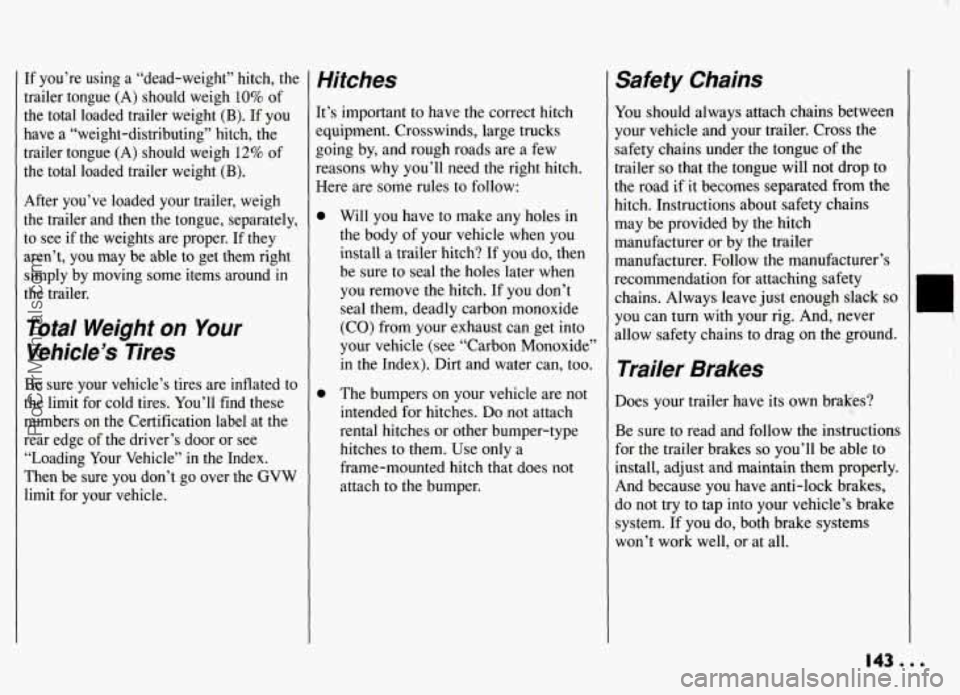
If you’re using a “dead-weight” hitch, the
trailer tongue
(A) should weigh 10% of
the total loaded trailer weight (B). If you
have
a “weight-distributing” hitch, the
trailer tongue
(A) should weigh 12% of
the total loaded trailer weight
(B).
After you’ve loaded your trailer, weigh
the trailer and then the tongue, separately, to see if the weights are proper. If they
aren’t, you may
be able to get them right
simply by moving some items around in
the trailer.
Total Weight on Your
Vehicle’s Tires
Be sure your vehicle’s tires are inflated to
the limit for cold tires. You’ll find these
numbers on the Certification label at the
rear edge of the driver’s door or see
“Loading Your Vehicle”
in the Index.
Then be sure you don’t go over the GVW
limit for your vehicle.
Hitches
It’s important to have the correct hitch
equipment. Crosswinds, large trucks
going by, and rough roads are a few
reasons
why you’ll need the right hitch.
Here are some rules to follow:
Will you have to make any holes in
the body
of your vehicle when you
install a trailer hitch? If
you do, then
be sure to seal the holes later when
you remove the hitch. If you don’t
seal them, deadly carbon monoxide
(CO) from your exhaust can get into
your vehicle (see “Carbon Monoxide”
in the Index). Dirt and water can, too.
The bumpers on your vehicle are
not
intended for hitches. Do not attach
rental hitches or other bumper-type hitches to them. Use only a
frame-mounted hitch that does not
attach to the bumper.
Sa#ety Chains
You should always attach chains between
your vehicle
and your trailer. Cross the
safety chains under the tongue of the
trailer
so that the tongue will not drop to
the road if it becomes separated from the
hitch. Instructions about safety chains may be provided by the hitch
manufacturer or by the trailer
manufacturer. Follow the manufacturer’s
recommendation for attaching safety chains. Always leave just enough slack
so
you can turn with your rig. And, never
allow safety chains to drag on the .ground.
Trailer Brakes
Does your trailer have its own brakes?
Be sure to read and follow the instructions
for the trailer brakes
so you’ll be able to
install, adjust and maintain them properly.
And because you have anti-lock brakes,
do not try to tap into your vehicle’s brake
system. If you do, both brake systems
won’t work well, or at all.
0
!
1
I I
!
143...
ProCarManuals.com
Page 153 of 274
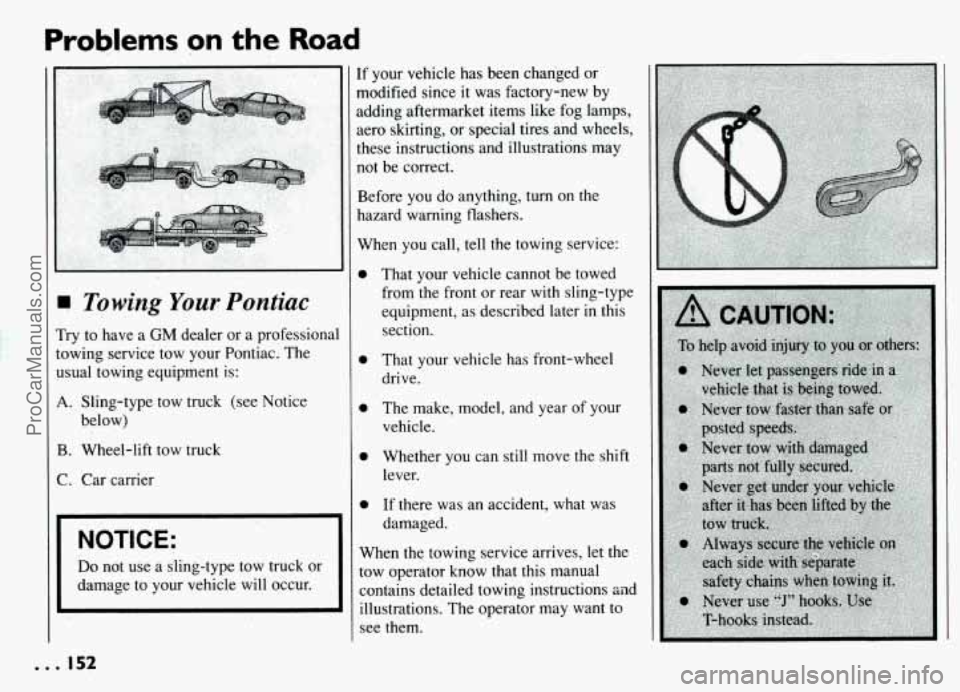
Problems .' on the .Road
3 Towing Your Pontiac
'ry to have a GM dealer or a professional
)wing service tow your Pontiac. The
sua1 towing equipment is:
L Sling-type tow truck (see Notice
below)
!. Wheel-lift tow truck
:. Car carrier
NOTICE:
Do not use a sling-type tow truck or
damage to your vehicle will occur.
If your vehicle has been changed or
modified since it was factory-new by
adding aftermarket items like fog lamps,
aero skirting, or special tires and wheels,
these instructions and illustrations may
not be correct.
Before you do anything, turn on the
hazard warning flashers.
When you call, tell the towing service:
0 That your vehicle cannot be towed
from the front or rear with sling-type
equipment, as described later in this
section.
0 That your vehicle has front-wheel
drive.
0 The make, model, and year of your
vehicle.
0 Whether you can still move the shift
lever.
0 If there was an accident, what was
damaged.
When the towing service arrives, let the
tow operator know that this manual
contains detailed towing instructions sad
illustrations: The operator may want to
see them.
ProCarManuals.com
Page 200 of 274

Inflation - Tire Pressure
The Tire-Loading Information label which is on the rear edge
of the driver’s
L
NOTICE: (Continued)
If your tires have too much air
door shows the correct-inflation pressures
for your tires, when they’re cold. “Cold”
means your vehicle has been sitting for at least three hours or driven no more than a
mile.
Don’t let anyone tell you that underinflation
or overinflation is all
right. It’s not. If your tires don’t
have enough air (underinflation)
0 Too much flexing
0 Too much heat
0 Tire overloading
0 Bad wear
0 Bad fuel economy.
I P
C
c
SI
I
,
(oierinflation), you can get:
0 Unusual wear
0 Bad handling
0 Rough ride
Needless damage from road
hazards.
Yhen to Check
lheck your tires once a month or more.
Ion’t forget your compact spare tire. It
ilould be at 60 psi (420 Pa).
How to Check
Use a good quality pocket-type gage to
:heck tire pressure. Simply looking at the
ires will not
tell you the pressure,
:specially if you have radial tires
--
which may look properly inflated even if
[hey’re underinflated.
;.. :.?
[f your tires have valve caps, be sure to
put them back on. They help prevent
leaks by keeping out dirt and moisture.
. . 1. .
,,
ProCarManuals.com
Page 202 of 274

0 The tread or sidewall is cracked, cut
or snagged deep enough to show cord
or fabric.
0 The tire has a bump, bulge or split.
0 The tire has a puncture, cut, or other
damage that can’t be repaired well
because of the size or location of
the
damage.
Buying New Tires
To find out what kind and size of tires you
need, look at the Tire-Loading Information label.
The tires installed on your vehicle when it
was new had a Tire Performance Criteria
Specification (TPC Spec) number on each
tire’s sidewall. When you get new tires,
get ones with that same TPC Spec
number. That way, your vehicle will
continue to have tires
that are designed to
give proper endurance, handling, speed
rating, traction, ride and other things
during normal service on your vehicle. If
your tires have an all-season tread design,
the TPC number will be followed by a
“MS” (for mud and snow).
If you ever replace your tires with those
not having a TPC Spec number, make
sure they are the same size, load range,
speed’rating and construction type (bias,
bias-belted
or radial) as your original
tires.
It’s all right to drive with your compact
spare, though. It was developed for use on
your vehicle.
Uniform Tire Quality
Grading
The following information relates to the
system developed by
the United States
National Highway Traffic Safety
Administration which grades tires by
treadwear, traction and temperature
performance. (This applies only to
vehicles sold in the United States.)
I’readwear
The treadwear grade is a comparative
eating based on the wear rate of the tire
when tested under controlled conditions
)n a specified government test course. For
:xample, a tire graded
150 would wear
me and a half
(1 1/2) times as well on the
;overnment course as a tire graded
100.
rhe relative performance of tires depends
upon the actual conditions of their use,
however, and may depart significantly
from
the norm due to variations in driving
habits, service practices and differences in
road characteristics and climate.
ProCarManuals.com
Page 203 of 274
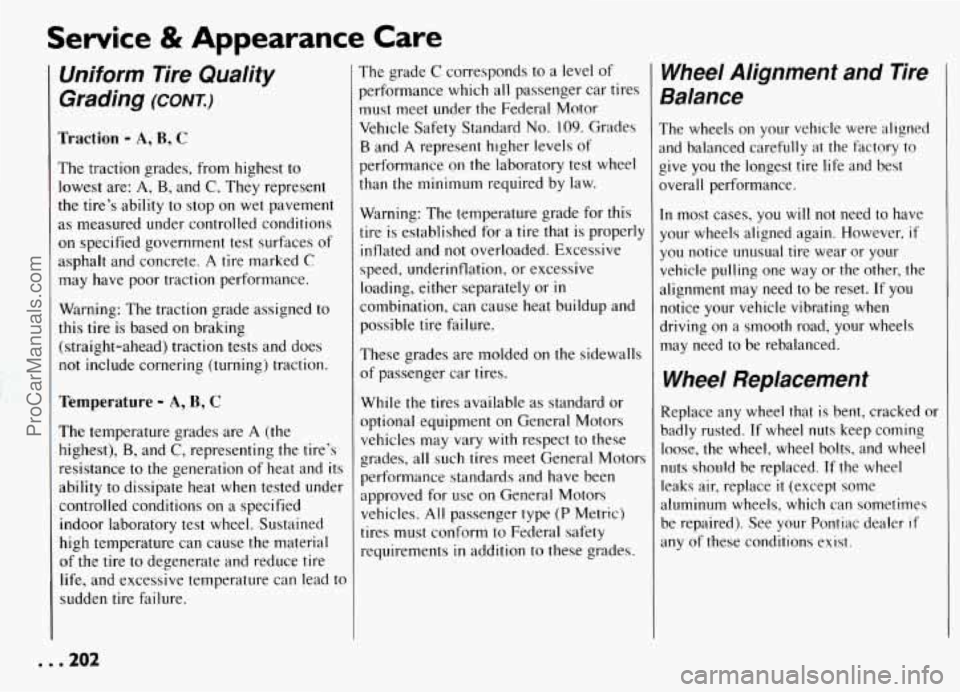
Service & Appearance Care
Uniform Tire Quality
Grading
(CONT.)
Traction - A, B, C
The traction grades, from highest to
lowest are: A,
B, and C. They represent
the tire’s ability to stop on wet pavement
as measured under controlled conditions
on specified government test surfaces of
asphalt and concrete.
A tire marked C
may have poor traction performance.
Warning: The traction grade assigned to
this tire is based on braking
(straight-ahead) traction tests and does
not include cornering (turning) traction.
Temperature - A, B, C
The temperature grades are A (the
highest),
B, and C, representing the tire’s
resistance to the generation
of heat and its
ability to dissipate heat when tested under
controlled conditions on a specified
indoor laboratory test wheel. Sustained
high temperature can cause the material
of the tire to degenerate and reduce tire
life, and excessive temperature can lead to
sudden tire failure.
The grade C corresponds to a level of
performance which all passenger car tires
must meet under the Federal Motor
Vehicle Safety Standard
No. 109. Grades
B and A represent higher levels of
performance on the laboratory test wheel
than the minimum required by law.
Warning: The temperature grade for this
tire is established for a tire that is properly
inflated and not overloaded. Excessive
speed, underinflation, or excessive
loading, either separately or
in
combination, can cause heat buildup and
possible tire failure.
These grades are molded on the sidewalls
of passenger car tires.
While the tires available as standard or
optional equipment on General Motors
vehicles may vary with respect to these
grades, all such tires meet General Motors
performance standards and have been
approved for use on General Motors
vehicles. All passenger type
(P Metric)
tires must conform to Federal safety
requirements
in addition to these grades.
Wheel Alignment and Tire
Balance
The wheels on your vehicle were aligned
and balanced carefully
at the factory to
give you the longest tire life and best
werall performance.
[n most cases, you will not need to have
your wheels aligned again. However,
if
you notice unusual tire wear or your
vehicle pulling one way or the other, the
alignment may need to be reset. If you
notice your vehicle vibrating when
driving on a smooth road, your wheels
may need to be rebalanced.
Wheel Replacement
Replace any wheel that is bent, cracked or
badly rusted. If wheel nuts keep coming
loose, the wheel, wheel bolts, and wheel
nuts should be replaced. If the wheel
leaks air, replace
it (except some
aluminum wheels, which can sometimes
be repaired). See your Pontiac dealer
if
any of these conditions exist.
. . .202
ProCarManuals.com
Page 204 of 274

Your dealer will know the kind of wheel
you need.
Each new wheel should have the same
load carrying capacity, diameter, width,
offset, and be mounted the same way as
the one
it replaces.
If you need to replace any of your wheels,
wheel bolts, or wheel nuts, replace them
only
with new GM original equipment
parts. This way, you
will be sure to have
the right wheel, wheel bolts, and wheel
nuts for your Pontiac model.
NOTICE:
The wrong wheel can also cause
problems
with bearing life, brake
cooling, speedometer/odometer
calibration, headlight aim, bumper
height, vehicle ground clearance,
and tire or tire chain clearance to the
body and chassis.
Used Replacement Wheels
‘ire Chains
NOTICE:
If your Pontiac has P195/70R14,
P2 15/60VR 14, P195/65R 15 or
P205/55R16 size tires, don’t use tire
chains; they can damage your
vehicle.
If you have other tires, use tire
chains only where legal and on
when you must. Use only
SAE
Class “S” type chains that are the
proper size for your tires. Install
them on the front tires and tighten
them as tightly
as possible with the
ends securely fastened. Drive slowly and follow the chain
manufacturer’s instructions. If you
can hear the chains contacting your
vehicle, stop and retighten them. If
the contact continues, slow down
until- it stops. Driving too fast with
chains on will damage your vehicle.
lr
ProCarManuals.com
Page 206 of 274
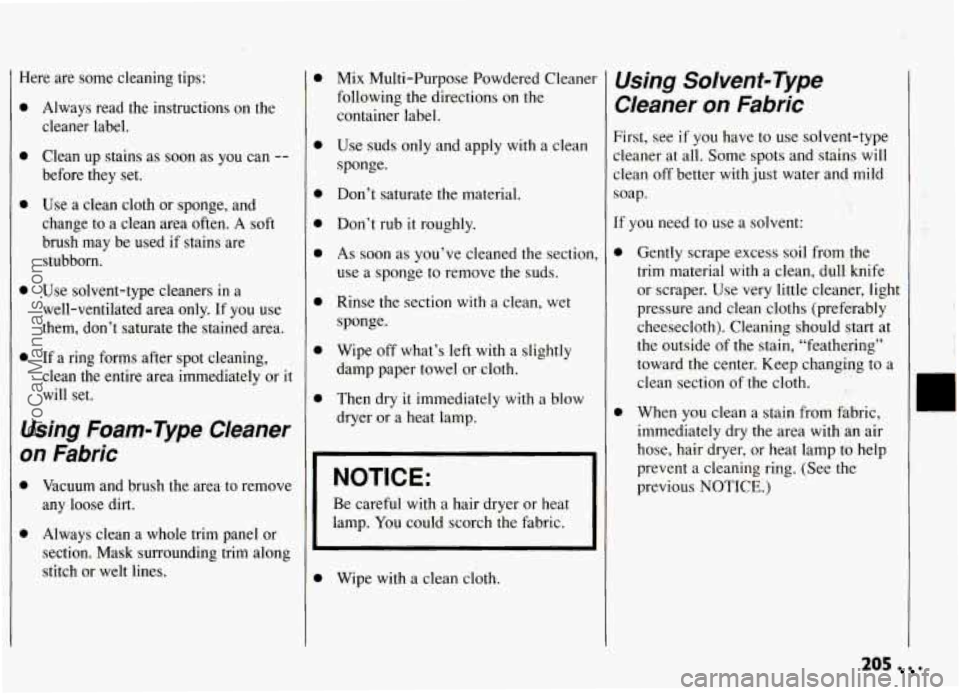
Here are some cleaning tips:
0
0
0
0
0
Always read the instructions on the
cleaner label.
Clean up stains as soon as you can
--
before they set.
Use a clean cloth or sponge, and
change to a clean area often. A soft
brush may be used if stains are
stubborn.
Use solvent-type cleaners in a
well-ventilated area only. If you use
them, don’t saturate the stained area.
If a ring forms after spot cleaning,
clean the entire area immediately or
it
will set.
Using Foam-Type Cleaner
on Fabric
0 Vacuum and brush the area to remove
any loose dirt.
0 Always clean a whole trim panel or
section. Mask surrounding trim along
stitch or welt lines.
0
0
0
0
0
0
0
0
Mix Multi-Purpose Powdered Cleaner
following .the directions on the
container label.
Use suds only and apply with a clean
sponge.
Don’t saturate the material.
Don’t rub
it roughly.
As soon as you’ve cleaned the section,
use a sponge to remove the suds.
Rinse
the section with a clean, wet
sponge.
Wipe off what’s left with a slightly
damp paper towel
or cloth.
Then dry it immediately with a blow
dryer or
a heat lamp.
NOTICE:
Be careful with a hair dryer or heat
lamp. You could scorch the fabric. ~
0 Wipe with a
clean cloth.
Using Solvent-Type
Cleaner on Fabric
First, see if you have to use solvent-type
cleaner at all. Some spots and stains will
clean off better
with just water and mild
soap.
If you need to use a solvent:
0
0
Gently scrape excess soil from the
trim material with a clean, dull knife
or scraper. Use very little cleaner, light
pressure and clean cloths (preferably
cheesecloth). Cleaning should start at
the outside
of the stain, “feathering”
toward the center. Keep changing to a
clean section of the cloth.
When you clean a stain from fabric,
immediately dry the area with an air
hose, hair dryer, or heat lamp to help
prevent a cleaning ring. (See the
previous NOTICE.)
205 .
ProCarManuals.com